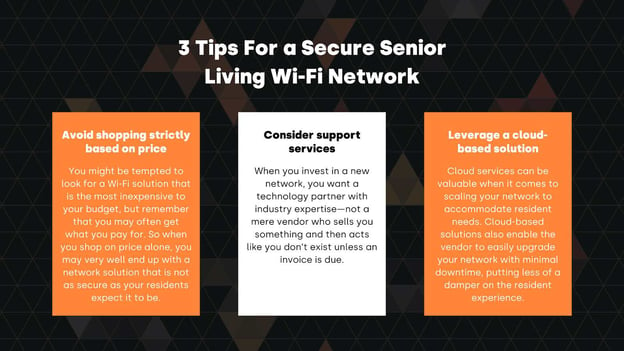The addition of Wi-Fi services to senior living properties is now a standard amenity and less of a diamond-in-the-rough offering. Many Healthcare properties offer Wi-Fi to their residents, either to drive competitive advantage or as an opportunity to upsell them on additional services.
Wi-Fi helps residents feel more at home.
.jpg?width=624&height=351&name=pasted%20image%200%20(2).jpg)
68 percent of baby boomers and 40 percent of the Silent Generation own smartphones, according to Pew Research. However, Wi-Fi in senior living communities is not without its share of concerns.
The emerging concerns about the prevalence of data breaches has raised businesses concerns; chief among these concerns is network security.
The Age of Data Breaches
Large corporations that have been hacked have made headlines across the news nationally. Data breaches can be quite expensive at an average total cost of $3.92 million per data breach. Hackers target organizations with a lot of high-value data such as customer profiles, credit card information, Social Security numbers, and other personal information.
As deep-pocketed organizations take proactive steps to reinforce their networks, bad actors are setting their sights on more vulnerable targets. Increasingly, those targets include healthcare providers, such as senior living communities.
Unfortunately for senior living operators, a single hack of a community can potentially result in bankruptcy. That being the case, it is critical to do everything within your power to make sure that the high-speed Internet you’re offering is secure.

3 Tips For a Secure Senior Living Wi-Fi Network
Security needs to be a top concern for every senior living community as more residents connect their devices to your network. When looking for a data network, you need to ensure that the solution you ultimately end up going with is reliable and secure.
With that in mind, here are three things to consider as you begin the process of investing in a modern network.
- Avoid shopping strictly based on price
You might be tempted to look for a Wi-Fi solution that is the most inexpensive to your budget, but remember that you may often get what you pay for. So when you shop on price alone, you may very well end up with a network solution that is not as secure as your residents expect it to be.
Some vendors that offer low prices could potentially be providing compromised hardware without even realizing it. But in reality, their infrastructure could be infected by firmware, spyware, malware, and more, as some low-priced network hardware is based on open source software, which can lead to your network being exposed to security risks. For the best results, do your due diligence. Make sure your provider uses industry-leading hardware and has solid security standards and processes in place.
In addition, while a homegrown network solution might offer a low price point, it comes with significant concerns about both the support load for your internal IT team, who clearly have other priorities, and access via the cloud to update and modify the network as needed.
- Consider support services
When you invest in a new network, you want a technology partner with industry expertise—not a mere vendor who sells you something and then acts like you don’t exist unless an invoice is due.
Leading network providers should have licensed technicians on hand 24/7 to troubleshoot network issues as they arise. The best vendors will be able to resolve issues in your community proactively—before your residents even notice—via remote access portals. Most importantly, be sure your solution offers resident phone support, and doesn’t leave your IT or maintenance team on an island to support all network-related requests from residents.
- Leverage a cloud-based solution
Cloud services can be valuable when it comes to scaling your network to accommodate resident needs. One benefit of cloud networks is that they can automatically update when patches and bug fixes roll out, ensuring that a hacker can’t simply exploit the latest security vulnerability to gain access to your critical systems. As an added bonus, cloud-based solutions also enable the vendor to easily upgrade your network with minimal downtime, putting less of a damper on the resident experience.
All networks might give users access to the Internet, but each of them is different. Spend some time researching your options, comparing vendors, and asking questions, and you’ll position yourself to make the right decision.
It’s Time to Upgrade Your Senior Living Wi-Fi Network
Over the last decade, Wi-Fi has evolved from something of a novelty to a bona fide must-have at senior living communities. But with so much on the line, you can’t just decide to invest in any network and expect great results. Depending on the size of your operation, a single breach could have devastating consequences.
With a strong network in place and a team of skilled professionals standing by to help at all times, you can give members of your community and their guests a robust Wi-Fi experience—and the peace of mind that comes with knowing their private data is protected. Let Allbridge help – learn more here.



